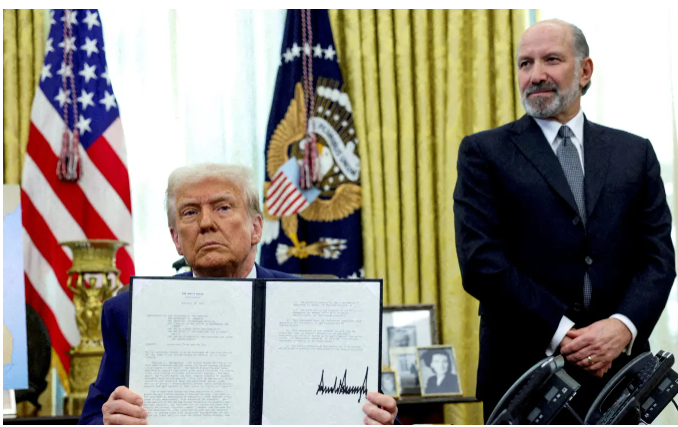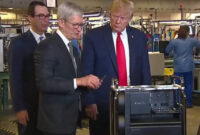On Wednesday, April 2, President Donald Trump declared that the United States would implement a new set of tariffs against its trading partners. The rates will vary from a base of 10% to as much as 49% for specific countries. These increases are scheduled to take effect starting April 5.
You can find a comprehensive list of the tariffs on the Rapid Response 47 account on X, managed by the Trump administration, which outlines every affected country. It spans nearly eight pages, with the initial two pages showcasing some of the most significant increases.
For instance, China will face a 34% tariff. The European Union will be subjected to a 20% increase. Vietnam is set to experience one of the highest tariffs at 46%, surpassed only by Cambodia at 49% and Laos at 48%.
The list continues: Taiwan will face a 32% tariff, Japan at 24%, South Korea at 25%, India at 26%, Venezuela at 15%, and so on. I emphasize Asian countries because many prominent global tech companies operate in these areas. “Businesses will transfer costs to US consumers, putting pressure on household budgets and dampening demand. The clear risk is a consumption slowdown that could cascade through the tech sector,” notes Counterpoint Research.
To illustrate, Vietnam hosts significant manufacturing facilities for Apple, which produces iPhones, iPads, MacBooks, and AirPods, among other products. “I guess the idea is to ‘make it too costly for smartphone OEMs to manufacture overseas, leading them to ultimately relocate to the US,’ comments Neil Shah, VP of Research at Counterpoint Research. Meanwhile, Foxconn, based in Taiwan, plays a crucial role in providing the world with smartphones, video game consoles, TVs, tablets, computers, communication networks, and hardware components.
As NBC News highlighted, “it was not immediately clear whether those tariffs would affect all products or focus on” specific items. Nevertheless, the implications of these new tariffs could be extensive. It is plausible that we may witness larger price increases affecting tech products amidst drastically rising costs. While price adjustments may not occur in the coming weeks, the months ahead will be crucial in determining where the market is headed.
President Trump has contended that the tariffs will motivate companies to invest in the United States. This has proven somewhat effective. In February, Apple announced a $500 billion investment in the US over the following four years, aimed at expanding its manufacturing presence in the US. This will include the creation of 20,000 new jobs and the construction of a new server factory in Texas.
While Apple seems ready to invest in the United States, it remains uncertain whether other firms will follow suit. Acer showed interest in possibly relocating manufacturing to the US, but so far, no steps have been taken.
Future price increases may take some time to reach retail and online outlets, but President Trump’s initiatives are already causing ripples as the stock market declines. According to CNBC, Apple’s stock value “dropped more than 7% in late trading Wednesday.” Nvidia, another tech firm with manufacturing in Taiwan, “declined by about 4%.” Amazon suffered a significant setback, falling by about 6%.
The ‘primary culprits’
Last year, the United States imported goods from China valued at $439 billion, making it the second-largest source of imports after Mexico.
Among the other “primary culprits” on which the US heavily relies for imported merchandise is Vietnam, which faces an overall 46% tariff; and Taiwan, which will incur a 32% tariff rate.
Vietnam ranked as the sixth largest source of products imported by the US last year, while Taiwan was the eighth, according to data from the US Census Bureau.
As tariffs act as a tax on imported goods, it is primarily American businesses that bear the initial costs when products from these nations arrive in the US. However, businesses may not always transfer the full added costs to consumers. In some instances, they may hold pre-existing contracts with their wholesale customers that lock in prices. Alternatively, they might choose to keep prices lower than the additional costs they face to retain their customers.
Even if more manufacturing shifts to the US—a place where Trump has repeatedly asserted that tariffs are “zero”—the costs of producing the same items that were previously sourced from abroad could result in price increases.
With that said, here are items likely to become significantly more expensive due to the new round of tariffs.
Laptops and tablets
China, Vietnam, and Taiwan accounted for the top three foreign suppliers of laptops and tablets to the US last year, delivering a total of $47.2 billion in goods, based on federal trade statistics.
Almost all consumer electronics, including smartphones and computer monitors, are expected to experience price hikes.
Moreover, given the US’s heavy reliance on Taiwan for semiconductors, consumers can anticipate increases in the prices of laptops, vehicles, household appliances, medical devices, Wi-Fi routers, and LED lightbulbs. These items often require numerous chips—new cars can contain thousands.
(Trump proposed a separate 25% tariff on semiconductors, but a fact sheet released by the White House on Wednesday indicated that such tariffs would not be additional to the reciprocal tariffs that were announced.)
Ed Brzytwa, vice president for international trade at the Consumer Technology Association, mentioned to CNN that it is expected to take three to four months for existing retail stocks to be depleted. At that time, consumers may begin to notice price increases “just in time for the back-to-school shopping season and the holidays.”
Footwear
Last year, China and Vietnam collectively sent $18.5 billion worth of shoes to the US, equating to nearly 70% of all shoes imported into the country.
Toys
China and Vietnam served as the primary sources of foreign toys shipped to the US last year, contributing a combined value of $15 billion.
The Toy Association estimates that 77% of all toys sold in the US are produced in China alone. “This industry is simply not structured to withstand a tariff of such scale,” said Greg Ahearn, president and CEO of the trade group, speaking about the impending 54% tariff on Chinese products.
According to him, American consumers are unlikely to see increased prices until late summer, when new items typically launch in advance of the back-to-school season and are shipped alongside essential toys.
Due to the relatively low profit margins in the toy sector, companies have limited capacity to absorb much of the increased costs resulting from tariffs. This challenge is even greater with the forthcoming 54% tariffs.
Toys manufactured in China that are sold in the US, he estimates, could see prices rise by at least 30% compared to current rates.
Clothing
If you want to understand the volume of apparel imported by the US, just check the labels on your clothing. If you notice many products labeled as made in China and Vietnam, you’re not alone. Both countries shipped roughly $14 billion worth of apparel to the US last year, ranking as the top two foreign sources for clothing.
Additionally, other significant foreign apparel suppliers, including Bangladesh, India, Indonesia, and Cambodia, are also facing “reciprocal tariffs” that range from 26% to 49%.
“The Trump tariffs will substantially affect the fashion sector,” stated Stephanie Gauzens, a spokesperson for the US Fashion Industry Association, during her conversation with CNN. Gauzens did not provide CNN with estimates on how much more Americans could potentially pay for clothing.
Is a recession looming in America?
If Trump maintains the tariffs announced on Wednesday, JPMorgan indicated in a note on Thursday that a recession is likely for both the United States and the global economy this year.
These tariffs are expected to drive up prices in America, contributing nearly 2% to the Consumer Price Index by 2025, according to the bank.
The primary indicator of US inflation has struggled to decrease in recent years, showing a 2.8% increase in February compared to the prior year, according to the Bureau of Labor Statistics data.
JPMorgan analysts noted, “This year’s total tariff increase should be interpreted as a tax hike of approximately $660 billion on the US,” emphasizing that this represents the largest tax increase in recent decades. “The effect on inflation will be significant.”
The overall economic “shock” from Trump’s tariffs will be worsened by any retaliatory actions taken by America’s trading partners against US products, the analysts also highlighted.
Retaliation is anticipated. Shortly after Trump made his announcement, the EU, the biggest single market for US goods exports, announced it was preparing counteractions, and China criticized what it termed “unilateral bullying” from the US and promised to respond.
Severe economic downturns are usually characterized by widespread job losses, bankruptcies, and foreclosures—quite the opposite of Trump’s goal to “Make America Wealthy Again” through his tariff initiatives.
The US president might still retract or lessen the tariffs announced on Wednesday, as he has previously done with other import duties over recent weeks. However, any new import taxes are likely to hinder the US economy, according to Donovan from UBS.
Similarly, economists at Deutsche Bank observed “a significant increase in recession risk in the US” in research published on Thursday.
What about the rest of the world?
Other economies are projected to suffer on multiple levels.
A recession or slowing economic growth in the US would prompt American consumers to reduce their spending, subsequently decreasing demand for foreign products.
If businesses outside the US experience a decline in demand for their goods, they might become more cautious, Donovan mentioned. “Will they continue to invest, or will they keep hiring people?”
Deutsche Bank economists predict that unemployment in the EU and the UK will rise over the next 12 to 18 months as a consequence of Trump’s tariffs.
These new import taxes may also reduce the demand for foreign products in America by making them pricier than US-made alternatives. That, naturally, aligns with Trump’s goal—he has stated that his tariff strategy is intended to boost demand for domestically manufactured products and enhance America’s manufacturing sector.
Additional challenges for exporters to the US include uncertainty, supply chain disruptions, and “burdensome” bureaucracy, according to Ursula von der Leyen, head of the EU’s executive branch. “All businesses, regardless of size, will experience difficulties from day one… The expenses associated with doing business with the United States will significantly rise,” she stated on Thursday.
Consumers outside the US will predominantly feel the effects if their governments engage in reciprocation with the Trump administration.
According to Thomas Sampson, an economics professor at the London School of Economics and Political Science, if there is no retaliation, the direct impact of US tariffs on European consumers would be relatively minor. However, increased tariffs on American imports to the region would lead to higher prices.
In such a scenario, “European consumers will face similar price hikes to those facing US consumers,” he clarified.
The EU responded to Trump’s earlier steel and aluminum tariffs by instituting countermeasures on up to 26 billion euros ($29 billion) worth of American goods exports, including tariffs on boats, bourbon, and motorcycles.
This time, the EU might choose to hold back. France’s finance minister stated on Friday that the bloc is not primarily considering reciprocal tariffs in reaction to Trump’s latest trade actions, as this could adversely impact European consumers. Options being explored include targeting specific firms rather than entire sectors, Eric Lombard informed CNN affiliate BFMTV.
However, other governments may not be as cautious. “If other countries retaliate, you may see similar inflationary pressures in those nations,” Antonio Fatas, an economics professor at business school INSEAD, mentioned to CNN.
Nonetheless, analysts suggest that America’s trading partners benefit from the simple fact that they will only face tariffs from one country—America—while the US faces retaliatory tariffs on its goods from numerous major trading partners.
Oxford Economics believes the global economy will likely avoid a recession this year. However, its performance is expected to be underwhelming. Growth might dip below 2%, according to Ben May, director of macroeconomic research, who penned a report on Thursday.
“It would represent the weakest annual growth rate since the global financial crisis, excluding the pandemic period,” he added.



